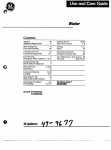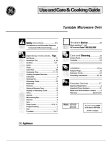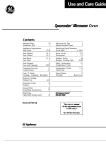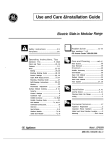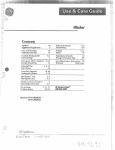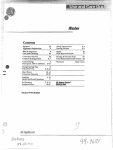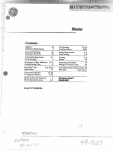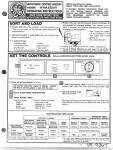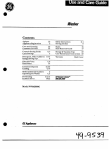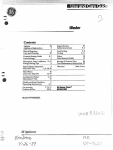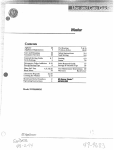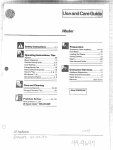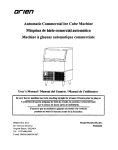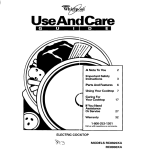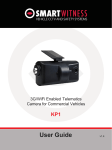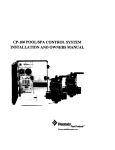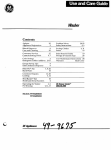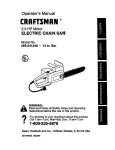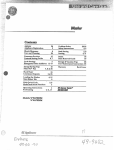Download GE WWA8606MAL User's Manual
Transcript
w
Agitator
Appliance Registration
22
2
Sorting
Stains
Care and Cleaning
Consumer Services
22
23
StainRemovalGuide
Storage &Vacation Tips
controls SettingGuide
CycleSettings
6,7
5
.
LimestoneDeposits
Loading the Washer
Model and SerialhTumbers
Operating Instructions
Pre-treating
Problem Solver
SafetyInstructions
Soak Setting
4,8,10
14
12,22
4, 10
2
4,5
7,9, 15
18-22
3,4
8
17
22
User Maintenance Instructions 22
BackCover
warranty
Detergents, Other Additives 11-15
Energy-SavingTips
8
FiIter-Flo@Pan
Hard Water
4,9
16
GEAnswerCentera
800.626.2000
u YouNeedseti@ :.
ReadthisbookcarefulIy.
It is intended to help you operate
and maintain your new washer
properly.
Keep it handy for answers to your
questions.
If you don’t understandsomething
or need more help, write (include
your phone number):
Consumer Affairs
GE Appliances
Appliance Park
Louisville, KY 40225
If you received
a
damagedwasher,.,
Immediately contact the dealer (or
builder) that sold you the washer.
Para obtener la versi6n en
espafiolde este manual,
name a
GE Answer Center,@
servicio de informaci6n
para el consumidor,
telgfono 800.626.2000
FORYOURSAFETY
smell gas:
Ifyou
1 open
windowsB
❑
2. Don’ttouch
Save time and money.
Before you requestSertice..e
Check the Problem Solver on
pages 18 through 22. It lists causes
of minor operating proble[ns that
you can correct yourself.
W~~~~ ~OW~ ~~~ ~0~~1
To obtain a Spanish language
version of t}]isbook, call
GE Answer Center”
800.626.2000
consumer informationservice.
and
seriai numbers.
YoLI’lifind them on a label on the
lower Ieft side near the front.
These numbers :lre :IISo011the
Consumer Product Ownership
I?cgistration Card that ~all~ewith
your washer. Before sending in this
card, please write these numbers
here:
electricalswitchesB*
3, Extinguish any
flames
open
4. ImmediatelyCall
your
gas
Suppliera
a
To obtain service, see the
=Consumer Services page in the
back of this book.
We’re proud of our service and
want you to be pleased. If for
some reason you are not happy
with the service you receive, here
are three steps to follow for
further help.
FIRST, contact the people who
serviced your appliance, Explain
why you are not pleased. In most
cases, this will solve the problem.
NEXT, if you are still not pleased,
write all the details—including
your phone number—to:
Manager, Consumer Relations
GE Appliances
Appliance Park
Louisville, Kentucky 40225
FINALLY,if your problem is still
not resolved, write:
‘.‘-
Major Appliance Consumer
Action Panel
20 North Wacker Drive
Chicago, Illinois 60606
‘Don’t turn electric switches
on or
because sparks may
ignite the gas.
off
Model Nutmber
Serial Nutnber
[Jsc [hesc lllllllbCI-S in ally
COrI-CSpOIldCilCC 01- service
calls
conccrnin: your washer.
....
.—_____
.-.-,..
———_.
-....... “_-..
._.,
____
--__-_~,
,-_
—.
.——..
!
of
fire,
@l&tic shwk~‘orhju~
to
~nom when Whg your
apptimee9fouow
basic
hclutig the
pmutiom,
tm apptimce
Ody for
ifi
@use
fouow@:
ktendd propose asdescribedin
thisUseand CareBook.
em Wmhermmt be properly
kwd
md Ioc.atd h
accordmce tith the btiuation
htmetiom
before it k Usd. E
youdidnotreceiveanksta.llation
hstructionssheetwithyourwasher,
youcanobtainoneby contacting
theservicelocationnearestyou.
—Wperiy gmmd to ‘cOdom
%%ith
m govetig codesad
@tinancw. FOROW
dem h
@Never
Nach
into
Wwher wMe it
is
meting.
BeforeIOafimgy
doadtig
inthe
or addingclothes,pmh
cycle selectorknob m
“STOP” position,
then wait
annti
the maetine
hascompletely
stopped beforeOpetingthe tid.
c~ose
is
Supetision k necessa~ w
ttis apptiance
med by or near
CtildrenoDo not
a~ow Chtidmnto
play imide,
on or Witil
or my &ardd
Dispose tismrded
and SMppingor
e
ttis
apptiance
apptimee.
of
apptiancw
paetig matetials properly.
Before Wsmrting a Wa$her,or
mmotig from sertiee9remove
the washer tide
* Keepalllaundryaids(suchas
detergents,bleaches,fabric
sofieners,etc.)outof thereachof
chldren,preferablyin a locked
cabinet.Observeallwarningson
containerlabelsto avoidpersonal
injury.
~KeeptheareaCaround
and
unde~neathyourappliancesfree
fromtheaccumulationof
combustiblematerials,suchas lint,
paper,rags,chemicals,etc.
~Keeptheflooraroundyour
appli~ances
cleananddly to reduce
thepossibilityof slipping.
~Tominimizethepossibilityof
electricshock,unplugthisappliance
fromthepowersupplybefore
attemptinganyrnaintena~lce
or
cleaning(excepttheremovaland
cletulingof thelintfilter).
NQTE: Turing theCycleselector
knobto an OW positio~~
doesIlOT
disconnectthe appliancefrom the
powerSupp]y.
o Do ll[ot‘tarl%p6r
~$yikb.
~Q1l’~p!}~o
*INeverclimbon or siand011the
washertop.
((”())
i/i;ll!<’{/
Ilt’.rl
l)[lgc)
/-:
.’
hpotint
stie@
@Do not operatethis applianceif
it is damaged,malfunctioning,
partiallydisassembled,or has
missingor brokenparts,
includinga damagedcord or
plug.
QDo not washfiberglassa~ticles
in your washer.Skin irritation
couIdresult from the remaining
m
particlesthatmay be pickedup
For washer operation
*me laundryprocesscan reduce
the flame retardancyof fabrics.
To avoid such a result. the
garmentrnanufacturer”scare
instructionsshouldbe followed
very carefully,
wash;n~ spin actionand jrevent
completio~~
of the cycle.
THESE
INSTRUCTIONS
SAVE
Howtooperate
your clothes
washer
WARNING—TO
reduce
the mPoRTANT
the
offire,
electric
risk
SAFETY
msTRucTIoNs
shock,
before
Water Level
\
topersons, read
WissMinse
~
SMALLa
WARM
.,
‘-Oln
e‘
cOLo
Colo
~
HOT
Coin
“ Sort clothes carefully by fabric
type, weight, color and amount of
soil, according to instructions on
page 9.
~Remove Filter-Flo@pan. The
underside of the lid is a good place
I()put the pan while loading or
unloading clothes.
m
m
setting
0 Load Clo[h(!sinto wash l>askct,
bcing care\’LIlnot t[>overload.
~]ol~]esshI>LI]d
be below rc{aining
t.illg.Scc lJ~~gcj() ff}r~]l~~r~
](l;]<ling
iii!’()[.i]l;l[ic>ll.
the
“.lfl~
m
“.
Soak
C9cl@
~0
*
/11.
M“.U. ! .“,! a
I
.
Permanenf Press
Cycle
1
‘O
Ill II ha—i
Ill Ill ) Hoff
1I
OFF
1~ ‘1 1’ e~A=
oeo~
—
I
~Position the Filter-Flo pan on the
agitator. Lint will collect in the pan
for easy removal when the wash is
finished.
NOTE: Do not use the Filter-Flo
pan as a wash basket. Do not put
any items to be washed in the
Filter-Flo pan.
See page 15 for information on how
to use bleach and fabric softener.
Cycles
‘“”’-7:; 3A
~ URGE
@Close the lid. Washer will fill but
not agitate or spin with the lid open.
wAdd nleasLlr-edamount of
(Ic(crgent. see
pa:es 1~ thrOLl~hi 5
for in~tirrnationon cietergentsand
othrr Idundry additives.
I
s
I
sorting
andLoading
1
Regu18r
.nit”,””
.. . .... .
a
-.
Heevy Drsty2 Speed Washer
Temp.
\
5 Cyc/eExtra Large Capacity
@
or injury
operating
this appliance.
AUTO
EWRARINSE
~m
Clean Cycle
@ SelectWashand Rinse
Temperature.
@ push CycleSelectorknobin
and turnclockwiseto your
selectedwashsetting.
Regular Cycle—automatically
providesNormalWashSpeedand
Fast Spin Speed.
Perm Press Cycl*automatically
providesGentleWash Speed and
Gentle Spin Speed,
controls
Use the Controls Setting Guideon
pages 6 and 7 to help you makethe
proper selections.
I
@ Select Water Level.
SMALL:~}asheris less than oneha]f full of clothes.
NIEDIUIV[:
Betweenone-halfand
two-thirds fLll].
~~~~~:
over two-thirds fLI~l.
I
@ Pull CycleSelectorknobout
to start the washer.If you wish to
changesettingafter washerhas
started,pushCycleSelectork~~ob
in to stop the washerand reset to~=’”-’
the new positio~l.
\_.,.l)
,/’
.,---
(‘.<
-,’.,
. ....—.—.
.—____
—..—
............- __=______
___
PermanentPress cyeIe—
For most cottons, linens and work
and play clothes. Two soil level
settingsare provided, but you can
sei the selector in-between, if
desired. Selection of these settings
automaticallyprovides for Normal
Speed, Fast Spin.
OFF
Regu$ar cycles
For polyester knits, delicates and
permanent press. An extended
cool-down spray rinse is provicied
to minimize the setting of
wrinkles. Selection of these
settings automaticallyprovides for
Gentle Speed Wash, Slow Spin.
OFF
I l-~
s
e
Soak Cycle ~ 0
START
Use with most soaking aids to
loosen embedded soils and stains.
See page 8.
Soak C’~c!e ~ o
NORMAL SOIL @
Permanent Press
OFF
/
I
NORMAL SOiL @ <
I
o@o@
~~F
AUTO EXTRA RINSE
OFF
For modern fabrics with heavy or
oily soil. A second rinse is
provided to help remove the
additional detergent that is
required for these soils.
-..
o
Regular Cycfes
cycle
Selector
Settings
g
,
/
Extra Clean
IVash
19
15
11
15
Spin
3’/2
3’/z
3’/2
7
2’/2
3’/2
3’/2
3
4’/2
3
3
7
7
soak
3’/z
7
—
spin
I
j
Permanent Press
Nc)rmai
Rinse
1
:
Special Cycle
Heavy
Rinse
Spin
:
Permanent Press
—Toiai‘irma
‘>;()-~fjs:
~-—-
35
,
11
31
24
,
“..-.
.
.
Permanent Press
@
42
-.. .-
,,.:..
—.
“
.
{
.———,—
—.—..—...
.—
-
—.
-—
—..
—.
.
.
—
—.—”
-=,.
—.———
,.
..-
,/
. .
.
ControlSettingGdde forWerent fabtiesandloads
————
I
Load
—
wash water
Temperature
cycle
Cottons and Linens
White/Colorfast
Bright/Non-colorfast
WorkClothes, Dungarees,etc.
Heavy Soil
Average Soil
Hot or Warm
Warm or Cold
Regular Cycles
Regular Cycles
Normal or Light Soil Setting
Normal or Light Soil Setting
Hot
Hot or Warm
Extra Cleaning Cycle
Regular Cycles
Set at Start
Normal Setting
Permanent Press, Treated Cottons,
Blends with Cottons
Heavy or oily soiI
Average or light soil
warm
Hot
Extra Cleaning Cycle
Permanent Press Cycle
Set at Stml
Permanent Press Setting
—————
Synthetics—Polyester,Nylon,
Acrylic Knits and WovenFabrics
Sturdy
Delicates
warm
Warm
Permanent Press Cycle
Permanent Press Cycle
Permanent Press Setting
Permanent Press Setting
Silks, Wools;Blends of Silk
and Wool
warm
Permanent Press Cycle
Permanent Press Setting
Rayon and Acetate
warm
Permanent Press Cycle
Permanent Press Setting
Down-filled garments, if machine
washing is recommended
Warm
Permanent Press Cycle
Permanent Press Setting
Baby Clothes—Sturdy,such as
Diapers, Nightgowns, Shirts, Pads,
Sheets. Receiving Blankets,
Coveralls
Hot
Regular Cycles
Normal or Light Soil Setting
Babj?Clcthes—Delicate
Warm
Permanent Press Cycle
Permanent Press Setting
Blankets—Wool, Part-Wool, Cotton
warm
Regular Cycles
5 min. soak then Light Soil Setting
Warm
Regular Cycles
5 min. soak then Light Soil Setting
Hot or Warm
Permanent Press Cycle
Permanent Press Setting
Hot or Warm
Permanent Press Cycle
Permanent Press Setting
Hot or Warm
Regular Cycles
Normal Setting
Cold or Warm
Regular Cycles
131ankets—Synthetic,Electric
Cur(ains-DO NOT NIACHINE
WASH FIBERGLASS
Chenilc Bedspreads. Robcs:*:K
.~.
1
~_
-
. -.
/
1
Slipcovers, Draperies. Buthmars
and Rugs;):*
.—
9
Dcnin]s (especially Indigo BllIe
Jc;lns) and o(hcr fabrics that bleed
k >.”
I
,+”
b
)<lll~bcr-coa(cditems, Laminated ~ Warm
IT:lbrics,Vinyl. Plastics and
i
I
I
Permanent Press Cycle
Permanent Press Cycle
Permanent Press Setting
~:
[~ .-
Permanent Press Setting depending
-
1- ‘-
on amount of soil.
‘“:CIICCICsize. Sf)nle slipc{)vers.dr;ipcrics and bedspreads nl;ly be 100large for automatic home-size washer.
----
—.
.--— -———.—
—-..
-.—.—..._
.,
,—.-...
,!
L.<
——--,-.
:.
-..+”...
—..r..,,,
m.-==-=”=”.
.
-,_.
_.
..-.
.,
Refer toGarmentMmtiactirers9
careLabels
‘-
[
Liquid chlorine type.
Only non-chlorine bleach when needed.
White or colorfast, liquid chlorine type.
Non-colorfast, only non-chlorinebleach
when needed.
If colorfast is unusuallysoiled, use hot water. Use maximum detergent recommended on
page 13.
Use maximumdetergent recommended in guide on page 13.
White or colorfast, liquid chlorine type,
Non-colorfast, only non-chlorinebleach
when needed.
Small loads reduce wrinkling.Use maximum Detergent recommended in guide on page 13.
Use Extra Clean Cycle—see page 5.
White or colorfast, liquid chlorine type.
Non-colorfast, only non-chlorine bleach
when needed.
If unusually soiled, use hot water, Use maximum detergent recommended in guide on
page 13. Small loads reduce wrinkling.
No bleach
Wash only if recommended by the garment manufacturer. Follow instructions carefully.
Seldom needed. If needed, use only
non-chlorine bleach.
Wash in your washer only if recommended by the garment manufacturer.
No bleach
Wash frequently to fluff up the down and retain the garment’s warmth. Wash separately. Wet
down gives off an odor which may be absorbed by other garments. Odor disappears when
garment is dry. Treat heavily soiled areas with liquid detergent or paste made of water and
granular detergent. Close zippers. Wash 2 or 3 at a time or add towels to balance.
GARMENT MUST BE TUMBLE DRIED.
White or colofidst, liquid chlorine type.
Youmay prefer to use a mild type detergent. Do baby clothes separately, Pretreat spots.
Rinse diapers, nightgowns,pads and sheets after use. Keep diapers in a covered pail of cold
water and conditioning agent like Borateem brand.
Only non-chlorine bieach when needed.
You may prefer to use a mild type detergent. Do hand-knit garments by hand.
No bleach
Fill washer, add detergent, allow to dissolve before adding blanket. Do one blanket at a time.
Pretreat heavily soiled spots with liquid detergent.
-
No bleach
On electric blanket, sew a strong piece of cloth over plug to protect blanket and washer from
damage. Do one blanket at a time: Pretreat heavily s6iled spots with liquid dete~ent.
White or colorfast, liquid chlorine type.
Vacuumout loose dirt before washing.
White or colorfast, liquid chlorine type.
Washonly 2 or 3 rllgs or mats at one time. Shake before washing to remove excess dirt.
White or coloti~st, liquid chlorine type,
For ncw “indigo blue” jeans, wash at least 3 times in very small loads with full water fill.
Jeans need ample room to move to avoi(i white lines at creases. May discolor plastic washer
parts. Subsequent washings will reduce discolorations, but will probably never eliminate it.
The staine(i parts wili not discolor subse(]uent washing loads.
Tllmble on FLUFF (No Heat)
Pillows are made of different l~~:itel.i:]ls–dac]<oll,
fiber, foam, polyester, natural feathers and
cio~vn.Many pi]]OWScan be machine wasiled. but i??a]ll{factz{rers’
care labc/s ;lzltstl~e.fbllo}t)e[l
c(/)i:/i/llj:T~~}’asilin:is rcc(l’nmcnded,cilcck pillows for weak seams or holes and mend to
prcverlt escape of feilthti~ or fiiling, Fiil washer, add detergent and agitate for several minutes
to ~iissolvcLirter:cnt. ,L4~i~i
t~vopiilows at a time to balance load, use high water level.
)
j’
. . . ... . . . . . .,—. ___.—__.__._-____
._.— __________________
. ..—.-.-.—
,.-
._ ... .. ..-._.,., _____________
-—-—
.- —-.——...—-—
- .. . .
How touse
the
How touse the
ra-‘
soakcycle
Filter=Flo@
Pan
-.
‘-
OFF START
Regular Cycles
Soak CYCIO~ 0
NORK!ALSOIL @
MEAW ~
‘
OFF*
II
\
\
\
I
Oe o@
AUTO EXTRARINSE
~~gS~A~ CYCLE)’ temperature
will automatically be cold.
eIf a hot or warmsoakis desired,set
the WASH/RINSETE~EM=
switchto “HOT/COLD”or
‘cWA~COLD” and turn the
Cycle SelectorKnob to “Normal”in
the Regular Cycles.Start the
washer.After washer fillsand
begins to agitate,push in the Cycle
Selector Knob and turn to “SOAK
CYCLE.” Pull out the Cycle
Selector Knob to completethe
cycle.
I
~For an efiendedsoak,allow the
washer to fill and agitatefor a few
minutes to dissolvethe soaking
agent. Then push in the CycleSelector Knob to stop the washer
(keep lid closed) and allow to soak
for as long as desired.After desired
soak period, pull out the Cycle
Selector Knob to complete the
cycle.
I
The Filter-Flo pan is the lint filter.
Position the Filter-Flo pan on the
agitator after loading clothes into
tie washer. Lint is easily seen and
removed after the wash is finished.
NOTE: Do not use the Filter-Flo
pan as a wash basket. Do not put
items to be washed in the Filter-Flo
pan. Do not place detergentpackets
in the Filter-Flopan.
—
-A..
..
Energ=sating Tips
If your clothesand household
itemsdon’tlookcleanand fresh
after washing,you will probably
re-washthem...and thatmeans
you’11wasteenergy,Rememberto
sort your clothescarefully,and
Joacfthemproperly,selectcorrect
cycles,useenoughdetergentand
tel)l~le~[ill{)’e \vot”}}l
choose({it’ll[e)”
(’)~c)i(ght{) i-c[e[{se c[iI[iget )-i[! qf
,Yoi[,
.....-—
.———..-. ,._,___
~Try to wash less often. Save
articles of the same type of fabric
until you have a full load.
@If you mustwashsmallerloads,
adjustthe amountof water.Small
loadsshouldhave lowerwater
levels.
~Washin off-peak hours. Your
local utility can tell you which are
the off-peak hours.
.-”>,
,-..”,-u_A—
. .._
—.
——
--..-.=
—=
.-..
=_...”
sortby soil
It pays tocheck and prepare
clothesforwashing.
Separate
(
from
~Do any necessay mending—rips,
hems, tears.
from
~Check all items for areas of
heavy soil or stain.
.
(
LINT PRODUCERS—such as
terry toweling and chenille—give
up lint.
LINT COLLECTORS—such as
man-made fibers and napped
fabrics like velveteen and
corduroy—attract lint. These must
be washed separately.
Kor more
o Emptypockets,brush out cuffs,
zip zippers, snap snaps, hooks and
buttons.
(
information
on lint
e Remove stains. For STAIN
REMOVAL GUIDE, SEE
PAGE 17.
from
w
(
Soaking and Pre-treating—
a good way to loosendeep soils
and stains.
sortby
color
Separate
—
“.
sortby fabric
—
e Turn Poly Knits inside-out to
minimize fabric surface damage.
w
1
Separate
(
from
w
(
A thorough soaking with detergent
or special soaking agent is another
way to remove heavy soils,
embedded dirt and even some
stains.
Soaking can be either a completely
separatewashing step or a
preliminarystep to a completewash
cycle. For detailedinformationon
how to soak in your washer, see
page 8.
FOR Information
ON
soAKmG AGENTS,
SEE
PAGE
15.
0Pre-treatheavysoilby rubbingin
from
from
#
(
from
a smallamountof liquiddete~gent
or a paste madeof waterand
powdereddetergentor soap.For
best results,wait 1/2hourbefore
washing.
from
from
I
——.
—-. .......————
——
________________________
______________ .—.
—.—.. .-..——..
1
,
—.——=.—
------
-
. . .<.-—..
_.
.=
_
. . . . . ..__
I ._ _
.
Howtoloadyourwasher
If you are machine-washing
Permanent Press clothes that you
plan to line dry or drip-dry, use
extra care to minimize wrinkling
in the wash process:
@Be careful not to overload
washer. Permanent Press clothes
must have ample room to move
freely. A Medium size Permanent
Press load is the largest that should
be washed.
oUse morewaterthanyou would
for a regularload.LTsea Medium
WaterLevelfor a SmallLoad;a
LargeWaterLevelfor a Medium
Load.
e Remove clothespromptlyas
soonas washerstopsand hang
immediately.
*~:
e.
~To minimizewrinkling,use the .~~;
PermanentPressCycle.
e
-“-’
@Load clothes dry.
@T~ke a properly sorted group of
ciothes and drop them loosely in
the wash basket in this order:
LiirgcItems-1ike sheets. Do not
wrap around the agitator.
This illustration, with clothes just
reaching the Clothes Retaining
Ring, shows a proper load. Clothes
have ample room to move because
they are not packed down, nor
wrapped around the agitator.
Clothes are loaded dry since wet
items are apt to pack down which
encourages overloading. This size
load requires a full water fill.
What is tile best size load of
clothes—large,
med~umy or
slnail?Save tiIne9energy and
small
items
—.-—..——
—like washcloths.
detergent by avoiding extra use of
the washer. Try to wash a full load
of clothes. If you can it is better to
save clothes until you have a full
load. If you must wash sma]ler
loads. save water, energy and
detergent by acl.justingthe water
level for the size of the load. See
~l;lgc:~1.
To add
items
afterthe washer
has
-
stitied.
oTurn off the washer.
~Carefullyremovethe Filter-Flo
pan.
.F
gAdd any additiond articles by
submerging them next to the
agitator.
i
[
..k
:
eReplacetheFilter-Flopan and
restartthe washer.
NO~: Do notuse the Filter-Flo
pan as a washbasket.Do notput
any itemsto be washed.in the
Filter-Hopan.Do notplace
detergentpacketsin the Filter-Flo
pan.
NOTE:When washing stocfings,
panty hose and other easily tanglegr..
items, always halqdleseparately.Tf }
minimize tangling, we reco~mmenk-‘
j
~
I:
Ii
{
I
k
/~i
[
I,
r
)i
]
~
~
Advanhges
—-
....,
PllosphatePowdered
Perform well in hard or soft water.
Are not available in some areas.
Detergen@
Wash all types of fabrics well.
Can be used in hot, warm, or
cold water.
IYon”PhosphatePowdered
Detergents
Perform satisfactorily in soft
or moderately hard water.
Generally do not clean well in
hard water.
In someareasonlynon-phosphate
productsare available.
May be difficult to dissolve,
especially in cold water,
Should not be used in cold water.
Those containing sodium
carbonate as an ingredient may
cause harmful limestone deposits
on clothes and washer when
combined with hard water.
(See page 12.)
Liquid Detergents
Perform well in soft water.
Offer better performance in
hard water than powdered
non-phosphate types.
May not perform as well as
powdered phosphate products
when diluted in wash water.
Cleansyntheticsand fabric
blendswell.
Are excellent as concentrates
for removing spots.
Completely dissolve even in
cold water.
Perform well in soft water.
Generally do not clean well in
medium--hardor hard water.
May combine with water
hardness minerals to form
sticl<ysoap curd.
.---— ______
The resd~
ofcontinued use ofcarbonate detergents
Is your water hard? If it is, and if
you use a carbonate type nonphosphate detergent,you will most
probably notice 1imestone*
deposits on your clothes and
washer surfaces,The hardnessof
your water and your washing
frequency will determinehow
rapidly the limestone will build up.
If your water is VERY HARD
(11 or more grains) and if you
wash just a few loads a week, you
may see limestonebuildups in just
a few months.
.&--.
-
.-
Effeetson clothes
Recommendedmethods to
Although limestone buildup occurs
more rapidly on cotton, it will
eventually affect various fabrics in
the following ways:
reduce
e Gives a stiff, harsh, rough feel to
fabrics such as toweling.
e Causes colors to fade and become
dull and dingy.
~Causes graying of fabrics.
~Leaves a white, powdery residue
on dark-colored items.
e Causes spot-fading of bright
colors as a result of direct contact
wi[h detergent.
~Reduces wrinkle-resistance of
permanent press fabrics.
e Destroys effectiveness of flameretardant finishes on cottons such
as children’s sleepwear,
~Increases fabric wear because of
the scrubbing action between
limestone deposits on the fabrics
during washer agitation.
Effects 011waslRer
QUnsightly buildup on all washer
s~irfacesexposed to the wash
S()]LltiO1l.
a Mat-like, crus(y f’ornlations”
Iint a(.ihcring[0 the
sticky limestone deposits.
C:lLISCd by
a Inci’case(iservice calls bCC:lLISC of
lin7cs[onccicp[]sitsin the pump,
rccircLllalioilwater hoses. filteI-S
limestone
buildups
@Use a powdered phosphate
detergent or a liquid detergent if
these are available in your area.
~Install a home water softener.
This will significantlyreduce
limestone buildup.
~Use a packaged non-precipitating
water softener, such as Calgon
brand with phosphate.
practices
may delay limestonedamage
to clothes
Good
washing
The following recommendations
will temporarily delay the effects
of limestone on your clothes.
These are generally good washing
practices and will give better soil
removal whether or not you have
hard water or use carbonate
detergent.
e Use hotter wash water, for
example Llpto 150”F.for cottons.
This also improves oily-soil
removal.
~If you wash in cooler water to
save energy, use more detergent to
promote better washing, Also be
sure to use bleach on bleachable
fabrics, Use hot water whenever
possible.
QAdd detergent and allow washer
to fil~and agitate for three or four
minutes to dissolve detergent
before adding clothes.
~Increaseuse of bleaches,presoaks,
packaged water conditioners,
prewash soil and stainremoversto
help in removingstubbornsoils
and stains.
—
~Use greatercare in sortingloads.
Wash very dirtyloads separately
and increasedetergentto help keep
dirt from redepositingon less
soiled items. Washdelicateitems
separatelyto preventdamage from
heavy, sturdyclothes.
eWash smallerloads to increase
cleaning action of washer.
~Use fabric softenerto counteract
stiffnessor harshnessin clothes. :~3$‘.—J&-@_:
..
How to patiially
restoreelot12es {--- .
*-..
Once clotheshave developed
deposits,they may be partially
restored bv soakingin a solution of
two cups ;f vineg; in one gallon of
hot tap”-waterfor-l5 minute;.
USE A PLAS~C CONTA~ER.
Then wash clothesin the washer
using detergent.
o Do
not use vinegar soak
solutionin washer.The acidic
actionof the vinegarmay
damagethe porcelain.
~ Vinegar soak solution may
reduce the wrinkle-resistance
of permanent press fabrics,
~Vinegar soak may damage
the dyes in some fabrics.
@~n~re:lse;]~~~oun~
of detergent>
Sec guide on opposite page for
rcconln~cnded detergent amounts
in rcla[ion t(>;~)~tit~i. hai.dness.
—-.,
(“”
i\
\_,,-.
)
4LlLflESTONE--tcctlntcall\rcalled CALCIUM CARBONATE–is caused by the
rcactlon of the calcil!m in the hard wafer with the sGdiumcarbonate in tt?edeiergent.
[
F
1
1
——
—
.—.——-—.
,
{
I
(
.-
: .-e “
., ‘rhe use of a sufficientamount
=’.”w- r)fdetergent is one of the most
~mportantthings you can do to
make sure your wash comes out
.
clean.
—
—.
-—
If the recommendedamount of
detergent produces too many suds,
switch to a low sudsingdetergent
brand, and follow instructionson
package.
-Amount required varies
accordingto:
1. Water hardness
2. Amount of soil
3. Size of load
4. Type of detergent
5. Wash temperature
Use more detergent if
you have...
i. Hard water
7 Large loads
-.
3. Greasy or oily soils
4. Lower wash temperature
5. Low phosphate detergent
How to use detergent—granular
I
or powered:
Add detergent next to the agitator
after the clothes have been loaded,
If your detergentdoesn’t dissolve
well, predissolve the detergent i]?
hot water, then pour directly into
the wash baslcet.
Using too littledetergentis a
common cause of laundlyproblems.
Always measure detergentin a
standardmeasuringcup.
Comended amountofdetergentforaveragesoiIload
I
Water
Hardness
VERY
HARD
Higl:-Sudsing
Powder ‘rype
10-20 Gr.
HARD
4-10Gr.
I
SOFT
1cup
()-1()
Gr:liils
i
I
->
/-,,.-.%.
-,
\
2cups
1>~CLIPS
()-4 Gr.
(.:
>-----:.,”
Large
CLIP
I
Medium
Small
1z cups
1%cups
1x
cups
1cup
Yi cup
x
cup
F cup
~: CLl~
1. Use recommended amount of
detergent for your load and water
hardness as shown in guide.
2. Whenusingotherdetergent
types-low andnormalsuds,
powders,liquids,non-phosphate
powders—followrecommendations
on package.
3. For hard water treatment, see
page 14.
——.
Hard water—
doyou have it?
Before you can decide what to do
about hard water, you need to
know if you have it and, if so, how
hard it is.
~If you; live in a municipal area,
contact your water company.
~If you live in a rural area, or in
some suburban areas, contact your
county agent.
The answer will be “you have ‘so
many grains’ per gallon” and
means this:
Oto 3 grains—SOFT
4 to 10 grains—HARD
11to 19 grains—VERY HARD
ZOgrains and over_
EXTREMELY HARD
If your water is SOFT,you have no
problem. You can use soap or
Detergent as you prefer and forget
all about hard water. If you have
HARD water—lessthan 10
grains— and you use phosphate
detergent, yoLlalso have no
problem.
But, if you have more than 10
grains, you will need to soften
your water with either...
1. An installedwatersoftenerin
yourhome,or
2. Theuse of a packagedwater
softener.
For more informationon water
softeners,
seeguide below.
Addthis muchwater softener witha full water
level
.—=
Grains of
hardness
When using
\vi[h detergent
Wflcn using
~vithsoap
o—lo
10—15
15—20
o
%cup
(60 ml)
v cup
3 cup
(160 ml)
(801111)
20—25
25—30
over 30
z cup
(120ml)
%cup
(240ml)
lcup
(240 ml)
1cup plus 1tablespoonfor every 5 grainsabove
30 (240 mlplus 15mlfor each extra 5 grains)
%cup
(180 ml)
1cup
( 160ml)
1X cups
(360 ml)
1Z cups plus 1tablespoonfor every 5 grains above
30 (300 ml plus 15mlfor each extra 5 grains)
,.
t
., ,,,[_-,
...-.———
—“—————..—_.-.—
—-—.—
.—_
--x-—>
..——.. -_..,.,
=,-- ._..,, ,. --,
.. .. .
.. . . ,,____
..
...—
.
.—
Laundry
Product
and
type
BLEACH
Chlorine Liquid
SUCII
as Clorox brand
Non-chlorine such as
C1orox2 brand
FABRIC SOFTENEM
Rinse additive such as
Downy Brand
Wash additive such as
Rain Barrel brand
SANITIZER
Chlorine bleach.
such as Clorox brand
*
w
How touse it
special
instructioKls
Dilute bleach with at least one quart
(0.96 liter) water and add after wash
action has started and detergent is
dissolved.
1) Do nut pour undiluted liquid chlorine Directly into
washer or on dry clothes.
2) Some of today’s washable fabrics should not be chlorine
bleached such as 100%cotton flame retardant children’s
sleepwear, silk. wool, mohair, spandex, leather or non-fast
colors. Dilute bleach before using on any fabric.
3) Check Manufacturers’ Care Labels for special instructions.
Follow package directions.
Put bleach into washer with detergent.
1) Maybe used on all kinds of fabrics.
2) Is most effective in hot water.
Mix recommended amount with one
cup (240 ml) water and add at start of
rinse cycle.
1) Helps make clothes fluffy and soft.
2) Reduces static electricity.
3) Use carefully. Too much may cause staining on
some clothes.
4) Do not pour directly on clothes.
5) For those recommended for adding to the wash cycle,
such as Rain Barrel brand. follow manufacturer’s
instructions exactly.
Follow package directions.
Add at start of wash cycle.
Use in case of infection and
contagious disease.
See under Bleach above.
Guards against infection by killing most bacteria and
viruses.
WA~ER SOFTENER
Non precipitating
such as Calgon Brand
Follow package directions.
Add during wash cycle.
Suspends hardness minerals in solution, keeping
water clear.
Precipitating such as
Borax brand
Follow package directions.
Use with detergent or soap in wash cycle.
Combines with water hardness minerals to form precipitate
which gives cloudy or milky appearance to water.
SOAK
AGENT
Such as Biz brand
Follow package directions.
I’l?E’?RE;AFING,STAIN
14NI}Sl>o’r REMOVERS
Follow package directions.Treat only
Such as Spray ‘n Wash
heavily soiled areas. check garments’
:111(1
r<2R f)rilllds
care labels for instrLlctions,
‘ollow package dircc[ions.
qOTE: tinted garments may not bc
:olorfiist. Wash separately.
-,>
‘j
CAUTION: Washer control panels and finishes may be
Damaged by some laundry pretreatment soil and stain
remover products if such products are sprayed on or have
direct contact with the washer. Apply these pretreatment
products away from washer The f~bric may then be
washed normally. Damage to your washer caused by
pretreatment products is not covered by yoLlrwarranty
Clean washer to avoid discoloration of next load. Go
Through comp]etc cycle (5 minute wash) using hot water,
1/2 cup (120 ml) detergent, 1 cup (240 ml) bleach. Wipe
exterior parts. Caution: Tinting may discolor plastic in
~vasher.Subsequent washings wi]] reduce discoloration
but may never eliminate it.
.—
.Howtoremove
stiins
1.
Try to remove stains as soon as
possible. The fresher the stain, the
easier it is to remove.
Removal Hint—
Using ChIorine Bleach for
White
and Bleaehable Fabrics.
2. Before attempting to remove
any stain, take thesesteps:
Mix 1/4cup (60 ml) chlorine
bleach with one gallon (3.8 liter) of
cool water—approximately80”F.
(27°C.)—in a sink or pan. Soak
stained area for 5 minutes and
launder in washer,
~ Find the fabric and the finish in
the chart on the next page, and use
only recommended methods.
s Check the care label instructions
that came with the g~arment.
s Test stain removal product on a
hidden inside seam or on a sample
of the material.
~Avoid use of hot water on
unknown stain. It can set some
stains.
3. FOIIOWstain removal with a
thorough rinsing.
4. Walshwith recommended
amount of soap or detergent.
Stain
seenextpage for
Removal
Guide.
stain
The Case of tile 661nvisible99
Stain.
Food or cooking oils on your
syntheticgarmentsmay cause stains
which are virtuallyinvisibleand
which you may not notice as you
put your clothes into the washer.
If these stains are not completely
removed in the wash, the oily spots
may pick up dirt from the wash
water. Then they will become very
visible and you may think they
were caused by the wash cycle
itself.
oncethese
spotsbecome
visibIe9how can
you remove
them?
@Rubin undilutedliquiddetergent
and let stand30 minutes,
@Re-washusinghottestwaterthe
fabriccan stand.
prevent
these
How can J’ou
“~f~~r.you-wash”
stains?
~Increase the amount of detergent
normally used.
~Increase water temperature where
fabric will permit.
gWash syntheticgarments more
often.
,,
(
\ —.,
whiteand
BieachabIe Fabrics
other
See Control Setting Guide, Bleach on Page 7
Adhesives
(ChewingGum, etc.)
Rubwithiceorimmerse
inverycoldwater.USedull tool to
care~lly scrape oflas i?luchadhesive or gut?zas possible. Sponge
with a safe dry cleaning fiuid,* then launder.
Same as white and bleachable fabrics.
Anti-perspirants,
Deodorants
Apply undiluted liquid detergent. Rinse. If stain remains, bleach
according to Stain Removal Hint on opposite page, If color has
changed, you may be able to restore it by sponging with
ammonia.**Rinse thoroughly.
Same as white and bleachable fabrics
except use non-chlorine bleach,
Blood
Soak in cold water, then launder in warm water. If stain remains,
bleach accordingto Stain Removal Hint on oppositepage, launder.
Sponge or soak in cool water, then
launder.
Chocolate, Cream,
Ice Cream and Milk
Soak in cold water. Treat stain with a safe dry cleaning fluid:~;
Apply undiluted liquid detergent, launder, dry. Bleach according
to Stain Removal Hint on opposite page, launder and dry.
Soak in cold water. Sponge with a safe
cleaning fluid,* Apply undiluted liquid
detergent. Launder in warm water.
Coffee and Tea
Without cream: Bleach according to Stain Removal Hint on
opposite page. Launder. With cream: Follow guide directions for
cream.
Sponge with warm water. If stain remains,
apply warm glycerine, let stand 30
minutes and rinse well, or sponge with a
safe dry cleaning fluid.* Launder.
Treat stain with safe dry cleaning fiuid.* Apply undiluted liquid
~etergent;launder and dry. Bleach according to Stain Removal
Hinton opposite page.
Sponge with a safe dry cleaning fluid.*
Then launder in warm detergent water.
leak stain in cool water. If stain remains, bleach according to
;tain RemovalHint on oppositepage, launder.
Spongewith warm water.Bleach remaining
stain with non-chlolinebleach.
Grass, Foliage, Flowers,
hlildew,Scorch
4pplyundilutedliquiddetergent.Launder.(Treatmildew spots
vhilethey are fresh, before mold has a chance to weaken fabric,)
f either type stain remains, bleach accordingto Stain Removal Hint
)noppositepage, launder.(Severe scorch cannot be removed.)
Spongewith warm water. Apply u~zdiluted
liquiddeterge}zt.Bleach remaining stain
with non-chlorinebleach, then launder.Old
mildew stains can seldom be removed.
Scorch can seldom be removed.
Ink,Ballpoint
‘reshstains: Place stain fi~cedown on an absorbent towel and
ponge with dry cleaning fluid,* or use spray cleaner. Apply
Same as white and bleachable fabrics
except launder using non-chlorine bleach.
Cosmetics: Eye Shadow,
Lipstick, Mascara, Liquid
or Pancake Makeup, Rouge
Powder; Crayon; Grease,
Oil, Tar, Cod Liver Oil
—
washable
Fabrics
esh Fuit, Fruit Juices,
Vne, Vegetablesor Food
~ Coloring
ndilurcdliquiddc[ergen[.
Oldstains:bleachaccording
toStain
.emova]Hintonoppositepage.
(lftenwithoil,Iurd~lrVaseline,
thenspongewithturpentine
or
.ul~naf~j].Launder in warm water.
Pililltand VJrnish
Pcrspiratit}n
Same as white and bleachable fabrics.
pp]y Lllldi]Ll[Cd ]j(~Lljd detC~geIlt and ]2Llnd~r
inwarm W[l[Cr.
]f
)iorhas chan:cd you may be able to restore it by treating with
atllnloniaor \’inegar.~:‘+:If any stain remains. treat with safe dry
cleaninglluid’;:[)r
according to Stain RCIIIOVfil
Hirlt
oil
oppositepage, laun(lcr and dry.
Launder in warm water.Rinse well. Bleach
with non-chlori]lebleach.
Apply111S[
l“C1lloVC~,
‘:’‘:using lllLIIILlfi.\CILII’~r’S directions.Rinse and
Same as white and bleachab]ef~brics.
bleach
——.
Rllst
I
;1
.—....—--. ..... .,---------------“.-
..L
-----
.-—-.—————
.—.
.—---.,
.-..,.,
. .. ,__.=_...
_
—...—
-...
-—....
;-
/’
.....-.
——
——-
..---.——.
Questions?
==::
.——
———
—
:~-:
~—
~ UsetMsProblemSolver
.—
PROBLEM
—
I POSSIBLE CAUSE AND REMEDY
LINT OR RESIDUE
ON CLOTHES
~Incorrect sorting of clothes. Separate lint producers (such as terry towels and chenille)
from lint receivers (such as man made fabrics, velveteen, corduroy).
~Washing too long, especially for smaller loads. For normal soil, wash one minute per
pound of dry clothes.
~Use of non-phosphate detergents which combine with hardness minerals to form a
precipitate which can be mistaken for lint. Use a phosphate or liquid Detergent; use
warmer wash water or soften water with an installedmechanical softener or a packaged
water softener.
@Powderyresiduefromgranulardetergentmay appearto be lint.Predissolvegranular
detergentin hotwaterbeforeaddingto washer;makesuredetergentis completely
dissolvedbeforeaddingclothes;switchto liquidor cold waterdetergentor warmer
washwater.Seepage 13.
~Overloadingwillcauseabrasionwhichcreatesexcessivelint.Washfeweritemswith
correctwaterlevel.
eToomuchBleach.Use correctamountof bleachaccordingto packagedirections.
@Not enoughdetergentto holdlint in suspensionduringwashcycle.Increase
amountof detergent.Seepage 13.
@Incorrectuse of fabricsoftener.If usedin washcycle,softenersmayreactwith
detergentto createa whitedeposit.Use softenersin rinsecycleonlyunlesspackage ,=$%
specifies adding to wash cycle. See page 15.
Q“Y*’
~Pilling usually on polyester-cotton blends is caused by normal wear and may look like
lint. Turning clothes inside-out may provide some help.
~Static electricity
y caused by overdrying will cause attraction. Use fabric softener in
rinse cycle.
GREASYOR OILY
STAINSON
LAUNDERED
GARMENTS
These are sometimes called “InvisibleStains”because you may not notice them before
washing clothes. However, if oily soils are not completely removed in wash cycle, the
oily spots may pick up di~~from the wash water.The spots will then be very visible.They
are ?lot caused by the washer. Wash syntheticgarments as soon as possible after wearing.
Use more detergent than normal and hottest water fabric can stand. If spots appear, rub in
undiluted 1iquiddetergent, let stand 30 minutes and rewash with extra detergent using
ht~ttestwater fabric can stand.
GRAYEIICLOTHES
....“
.
n
-, (.;
.,,,
.: ,+,
..-——
* 1nsuff~cient detergent. YOLImay need to increase amount of detergent used if load is
larger than normal, if soils are oily or heavier than average, if water level is large or if
water is [-iardto Extremely Hard.
a Water not hot enough for type of load. Be sure water heater is set to deliver hot water [it
the w?:~sher
at 140°–150°F.Do not wash when other hot water needs—such [is
dishwasi~ingor Familybaths-are heavy.
*Poor or infcrior detergent. Change to phosphate detergent, if possible.Follow these steps:
1. USCwater conditioner, (such as Calgon brand)
q Prc-[!.e;iistains
A..
I
i
/
.
. .
.
.’,
--—
—,
.,.
---
.—
—-
—
——
———.....
1
— ....—...
-____
——-—-.
—--.....- ......——
.——.
-----,.,—.
_________
—.———.
,
;
........
—
POSSIBLE CAUSE AND REMEDY
~Washer overloaded.Clothes cannot move freely to loosen and.remove soil, causing
gray appearance. Follow correct loading procedures for size of load.
QImproper soaking with insufficientdetergent. Usually a 30-minute soak is sufficient.
However, when using extended so~aksfor heavily soiled garments, you may need to use
twice the recommended amount of detergent.
~Use of soap in hard water. Switch to a phosphate detergent, or follow six steps at the
bottom of page 18.
@Washingtoo long may result in increased soil deposition. Use shorter wash times for
smaller loads.
e Detergent dis~olvestoo slowly. Detergent must be present in the wash solution at the
start of agitation. See page 13.
@To restore grayed clothes, follow one of these procedures:
1. Put clothes in washer. Fill with HOT water. Check Manufacturer’s Care Labels to
determine if hot water is suitable for garment.
e Add a non-precipitatingtype of water softener such as Calgon with phosphate—
use 2i/t times as much as you need for normal water softening.
~Do not use detergent or soap.
o A11owclothes to go through complete cycle.
@Repeat, if necessary.
2. If you prefer to use the Soak Cycle, see page 8. Use the water softener in place of
soak agent or prewash detergent and allow clothes to soak for about 20 minutes.
—_
—
——”
YELLOWED
CLOTHES
~Incompleteremovalof bodysoildueto constantuse of insufficientdetergent.Check
hem of T-shirtor pillowcase.If theyare whiteand centeris yellow,it containsbody
oil. Restorewhitenessfollowingprocedureson “GrayedClothes,”above.
~Chlorinebleachmay yellowsomefabricswithresin finishes.Use oxygenbleach
[suchas C1orox2 brand).Refer to GarmentManufacturer’sCareInstructions.Restore
uolorusingcolorremover(suchas Rit or Tintexbrands),followingpackageinstructions.
$Iron or manganesein watermay causeoverallyellowingor yellowspots.
1.Use extradetergentplus a non-precipitatingwatersoftenerdissolvedin waterbefore
addingclothes.Use non-chlorinebleach.
2. Havea specialfilteror chemicalfeederinstalledin you hometo removeiron and
manganesefrom water.
3. Run hot waterfor a fcw minutesto cleaniron residuebuildupin lines;drainwater
heateroccasionally,
‘I.Toremovespots:spreadstainedportionoverpan of boilingwaterand squeeze
lemonjuice throughstain.Toremoveoverallyellow,use a commerciallyavailabler~~st
scale removet-,following package instructions. 1f porcelaindamagecan occur,do not
use in the washer;use a plasticcontainer.
—.—
——-..—
.-..-.-.—...
........ .. .....______________
———————.
.__—
—=*=
POSSIBLE CAUSE AND REMEDY
SHRINKAGE,
~NITS
----
* Relaxationshrinkage can occLlrin knit fabrics that have been improperly stretched
and elongated by the manufacturer.When this occLlrs,garment may be pressed back
into shape after each wash and dry cycle.
* Progressive or delayed shrinkage is caused when starch or sizing (in some fabrics) is
gradually removed by laundering. May be noticed in older garments that have been
washed many times without previous shrinkage.Treat as for Relaxation shrinkage
above.
~ ~hri~~kagecaused by overheatingoccurs in certain knit fabrics that have been heatshaped. When washing, drying or ironing temperatures exceed the temperatures used to
shape set, shrinkage may occur. This cannot be corrected, but it can be prevented by
washing in cool or warm water and drying on Low or Delicate heat.
~Leaving clothes in dryer after tumbling stops. Remove and hang clothes immediately.
WRINKLING IN
PERMANENT PRESS
AND “NO-IRON”
ITEMS
* Too many clothes in dryer. Dry only one washer load at a time. Do not combine loads.
*Improper loads. Avoid laundering heavy Permanent Press items, such as work
clothes, with lighter Permanent Press items such as shirts or blouses. Do not wash
Permanent Press with regular laundry.
~Too many clothes in washer. Permanent Press loads should always be smaller than
regul~ loads...no more than medium loads to give clothes room to move freely.
~Incorrectwashand dry cycles.Use PermanentPressWashcyclewhichprovidesa co
downrinse to minimizewrinkling.Alsouse PermanentPressDry cycle.
~Incorrect water level. Use LargeWaterLevelfor MediumLoad)MediunlLevelfox
_—[. _-
SmallLoad.
~Repeatedwashingin too hot water.Washin coldor warmwaterwithplentyof
detergent.
e Accumulationof lime scaledue to use of carbonatedetergents.If you mustuse a nonphosphatedetergent,avoidthe use of high-carbonate-builtdetergent.
~FailLlreto use fabric softener. Proper Llsewill minimize wrinkling.
To remove Ivrinkles:
* Rctumble on “Permanent Press” setting.
~Rerinse and dry on “Pcrn~anentPress” setting.
s If unsuccessful, retumble on high heat for 10 to 12 minutes and hang immediately.
Qsend to dry cleaners i’orpressing.
i ~ Some w~inkles may remain which cannot be removed.
i
,..
.....__
—..—
- .. ..--—---............. . ........=.“.”,
.——
———
-—..
,-=.
P.
,.
.,.’ ,,
d
———--—.—--.
—..
—.—
.—-.....—.
.. ..—.—————.———-..—
- —-——
.
—— .——.
.—.
—..-——.
-.....?.
............ .....—.——.—
POSSIBLE CAUSE AND ~EME~y
.
L,
—
_-=_
-:
SXAGS, HOLES
TEARS, RIPS OR
EXCESSIVE WEAR
(continued)
~Chemicals such as hair bleach, dye, permanent wave solutions,battery acids and
toilet bowl cleaners may cause fabric holes. Rinse all towels and other articles that
came in contact with these chemicals before putting them in wash. Do not contaminate
clothing articles with these chemicals.
g Small, unnoticed tears may enlarge du~ingwashing process. Check garments before
washing and mend all rips and tears.
*As Permanent Press garments age, they may show fraying at collars and cuffs. This is
normal due to weakening of fibers by the Permanent Press process. It is not caused by
washer. You can slow this process by washing small Permanent Press loads with a
Large Water Level. Do not wash heavy items such as towels with Permanent Press.
Remove collar stays, when possible.
eRoughness or burrs on agitator may cause rips or tears. Check agitator and file rough
spots if necessary.
.-
*May be caused by the use of Regular Cycles for delicate articles. Use Permanent Press
Cycle. Refer to Garment Manufacturer’s Care Labels.
QGments weakened by age, sun or atmosphere. This is inevitable and is not caused by
washer. Slow process by washing on Permanent Press Cycle.
0Too large loads, or too little water. Load washer only with number of items that will
move freely. Select correct water level.
EAVILYSOILED
———
AREASsuch aS
Pretreatwith liquiddetergent,
---—-
o-
1
@
Makersure cord is pluggedinto outlet.
Make sure both hot and cold faucetsare turnedon.
Make sLlrecontrols are set and cycle selector knob is pulled out to ON position.
Make sure lifl is closed. Washer will fill but will not spin or agitate with liclopen.
Check house fuses or circuit breakers. If another appliance is sharing the electrical
utiet, remove it. Washer should have separate outlet,
Make sure ien]~]erat~!reselector switches are correct]y set.
oMiakesure hot and cold Fducetsare turned on and
I“egulafe(!correct~y.
.—.
.,
,,---
[=”
\,
.:
-c.—
--‘\
,\
--
————.—.......—
- .-
——
.--——. —.._..-
—-—
———.—--..-—.-.
.- -.
.—
-.
I
PROBLEM
POSSIBLE
WATER
CAUSE AND mMEDY
--
e Make sure drain hose is not kinked.
WON’T DRAIN
oTop of drain outlet should be less than 8 ft. above floor.
WATERLEAKS’
@Make sure hose connectionsare tight at faucets.
*Make sure end of drain hose is correctly inserted in and secui-edto drain facilitv.
WASHER IS NOISY
@NIakesurewasheris levelandfirmto thefloorwithrubberfootpadsin placeand
frontjam nutstight.SeeyourInstallationInstructions.
*A sharp,distinctivesoundwillbe heardat the end of each spinperiodas the motor
stopsandthe spinbrakeinsidethetransmission“locksin.” Thissoundis normal.
*Heavilyunbalancedloadscancausethewasherto vibrateexcessivelyduringspin,
andmaycauseit to movefromits originalposition.In extremecases(usuallyoccurs
whenwashinga single,heavyitemor a smallload whenwaterlevelis sethigherthan
necessary),the spinbasketmaystrikethe outertub,creatinga loudbut harmlessnoise.
Tocorrect,openthe lid andredistributethe loadevenlyaboutthe washbasket.Close
the lid andrestart.
WASHER PAUSES
IN C~~LE
H you
need
more
*Washernolnally pausesbetweenwashingsteps..,suchas betweenwashand spinor”
betweenspin and rinse.
help...cau,
toll free:
GE
Amwer
center@
/ 800*626.2000/
consumer information servic
careandcleating
USER MAINTENANCE
INSTRUCTIONS
The ta~b.The porcelain is selfcleaning. Leave Iid open after
washing tocillobi
Jinoist[[t-(~ to
~JI~~Il}(Jrc~?e.
D()not use harsh or
gritty cicansers.
Tile exterior. Wipe off any spills
of washjng conlpounds.” Wipe or
dLls[with danlp c]oth. Try no[ [o
hit surfilcc with sharp objcc(s.
Whenreplacingthe agitator,
carefullylowerstraightdown
onto the shaft so thatit fits into
the slots.Then applydownward
pressureuntilagitatorsnapsinto
its normalposition.
HOW ~0 ~~~OV~ limestone
deposits
frolm
clogged
Filter
Ylo@
pan
eSoak filterpan in a preheated
I
Ask scrvicc technician to remove
\Y;lter from drain pLlmp ilIld hoses
I
~~e AetiVatOT[sIagititoF.
Remove
at regular intervals-about 4 to 6
months-and remove any lint that
may have accumulated. No tools are
needed, simply grasp agitator with
10prcvcn(freezing,
Do not store [hc washer Ivhcrc it
;~t’illbc exposed to the weather.
both hands and pLIilstraight up
sh:lrply. The slotted ,;ection at the
top 0/’the met:li shafi has a light
coating of ]uhricanl to prevent palls
S[ i(:kin: together. 1( this area appears
t(>be d~~~,
appl)l a light coat of grease
or petroleum jcl(y ar<)uilcithe slotted
:;ccii(ln (j i’~ht:sh;lft before re~31acing
[}lc ~j:il;i[or. Do jlot overgreasc.
160”F.(71“C.)solutionof half
vinegarand half waterfor 15
minutes.Then brusheach side of
pan with a stiff bristlebrush wl~ile
flushingwith runningwater.
cAu~~~~~:
CY
Do not soak in porcelain
container.Vinegarca~~damage ‘<’>
f,...-*’
)
porcelain.
\
l--
QDo not exceed 180”F.~82°C.)
or filter pan may warp.
——
—.
.—-.,
,-?
.,,?.;,
,/,
f--’(L..-,
!
.4.
.—
—
.—
____
!
——
. ..
. .
. .. . .
. _._.
—.—
_,...
.———_
.—-.
.___...,.
___,____
major apfilianc~,GE~swer Cen~e@
informationserviceis availableto
help.Yourcall-and yourquestion—
willbe answeredpromptlyand
courteously,And you can callany
time.GEAnswerCente@serviceis
open 24 hours a day ‘7daysa week.
.
t+’dlprovideexpert repair service,
scheduledat a time that’sconvenient
for you. ManyGEConsumerService
companyoperated locationsoffer you
sel~icetodayor tomorrow,or at your
convenience(700 a.m. to %00p.m.
~~.eekdays,
9:00a.m.to 2:00p.m.Satu~
da}s).Our factory-trainedtechnicians
knowyour applialce insideand out—
so most repairs can be handled injust
one visit.
J
,
!
You can havethe secure feeling that
GE ConsumerServicewillstillbe
there after yourwarrantyexpires.Purchasea GE contractwhileyourwarranty is stillin effectand you’llreceive
a substantialdiscount.Witha multiple
yearcontract,you’reassuredof fiture
serviceat today’sprices.
~
TelecommunicationDevicefor the Deaf
I
]
i
YOURGE AUTOMATIC
CLOTHESWASHER
WARRANTY
Save proof of origins! purchase date such as your salesslip or cancelledcheck to establish warranty period.
WHATIs COVERED
FULL ONE-YEAR WARRANTY
For one year from date of original
purchase, we will provide, free of
charge, parts and sewice labor
in your home to repair or replace
any pafi of the wasl?erthat fails
because of a manufacturingdefect.
LIMITED ADDITlONAL
FOUR-YEARWARRANTY
For the second through fifth year
from date of original purchase, we
will provide, free of charge,
replacement parts for any pati of
the transmission that fails because
of a manufacturing defect. You pay
for the service trip to your home
and service labor charges. Or, if
you desire, we will provide a
completely reconditioned
transmission. You pay for the
shop reconditioning labor, the
service trip to your home and
service labor charges.
III
WHATIs NOT COVERED
and Care material.
Read
your
Use
II
j
~Service trips to your home to
teach you how to use the product.
If you then have any questions
about operating the product,
please contact your dealer or our
Consumer Affairs office at the
address below, or call, toll free:
GE Answer Center@
800.626,2000
consumer information service
@improper installation.
If you have an installation problem,
contact your dealer or i17staller,
You are-responsible for providing
adequate electrical, plumbing and
other connecting facilities.
This warranty is extended to
the original purchasera!~dany
succeeding owner for products
purchasedfor ordinary home use
in the 48 mainland states, Hawaii
and Washington,D.C. In Alaska the
warranty is the same except that it
is LIMITED because you must pay
to ship the product to the service
shop or for the servicetechnician’s
travel costs to your home.
All warranty service will be
provided by our Factory Service ,
Centers or by our authorized
Customer Care” servicers during
normal working hours.
Look in the White or Yellow Pages
of your telephone directory for
GENERAL ELECTRIC COMPANY,
GENERAL ELECTRIC FACTORY
SERVICE, GENERAL ELECTRICHOTPOINT FACTORYSERVICE or
GENERAL ELECTRICCUSTOMER
CARE@SERVICE,
m
~Replacement of house fuses or
resetting of circuit breakers.
a Faiiure of the product if it is used
for other than its intended purpose
or used commercially.
“
@Damage to product caused by
accident, fire, floods or acts of God.
WARRANTOR 1SNOT
RESPONSIBLE FOR
CONSEQUENTIAL DAMAGES.
:._.”
J
~’. - .—.- ----i;
Some slat~s do not allow the exclusicn or limitation of incidental or consequential damages, so the above limitation or exclusion
may not app:y to you. This warranty gives you specific legal rights, and you may also have other rights which vary from state to state.
10 know wkat your legal rights are in your state, consult your local or state consumer affairs office or your state’s Attorney General.
~~
.,
;,
;
.,,
i—
/-\}i
.-..-—
(;(;
J
i
[
I
,
,
1
























